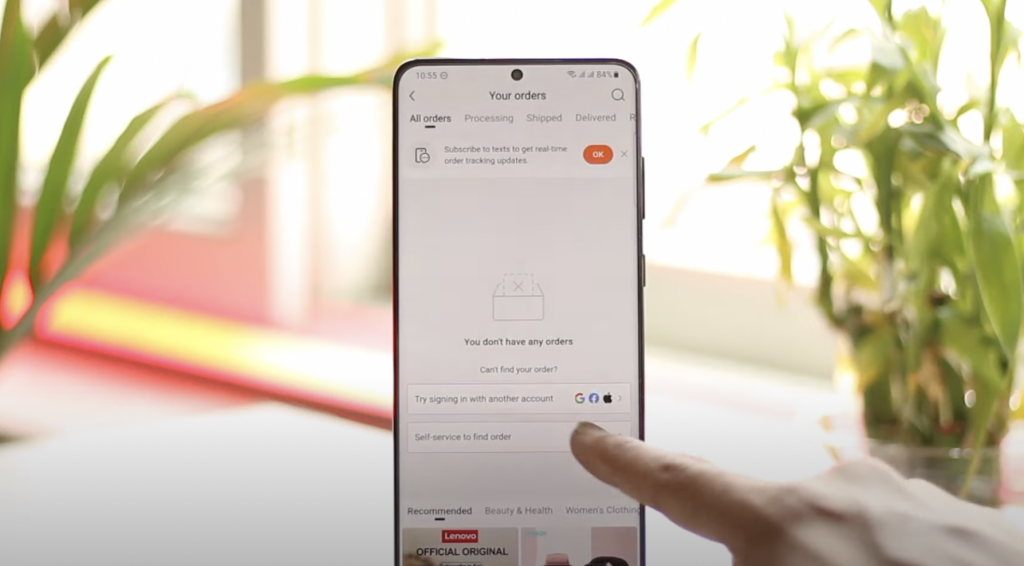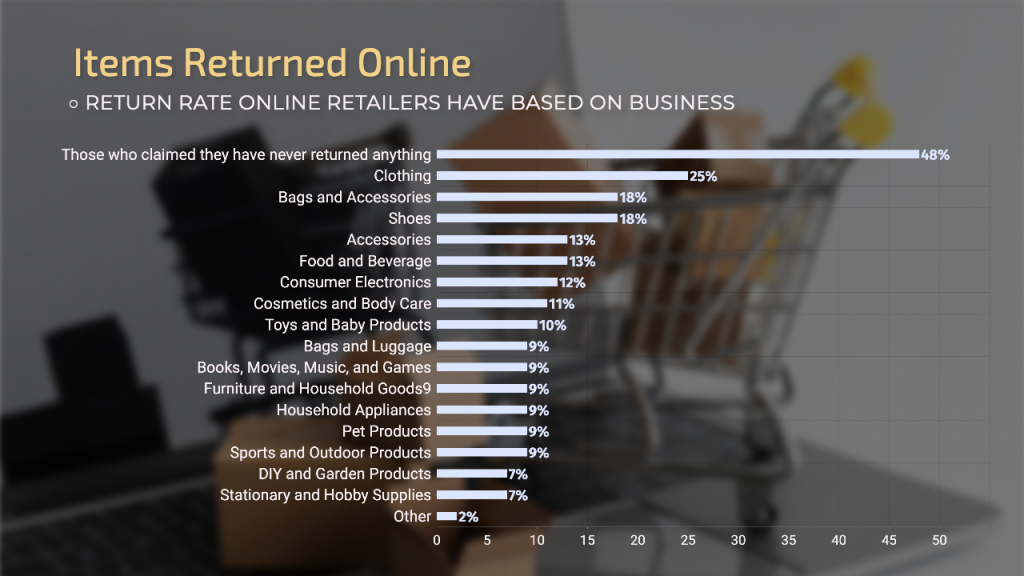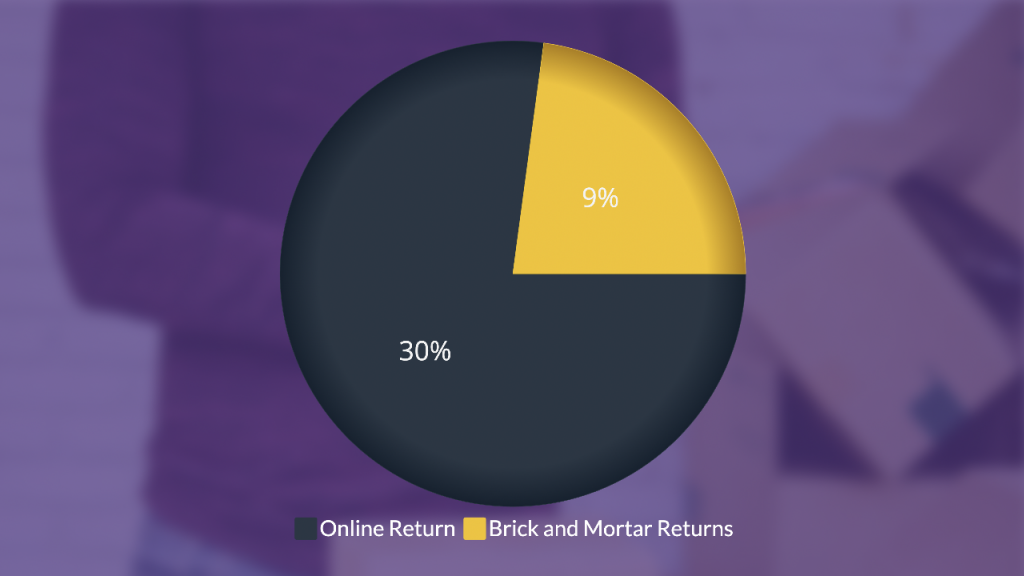In recent years, consumers have started to rely more on online shopping to purchase items, saving them from having to travel to a brick-and-mortar location to shop. According to the National Retail Federation, a little more than 26 percent of all purchases in 2022 were made online, accounting for $1.29 billion.
Table of content
- 1. Create a Return Policy That is Fair to Consumers Making Online Returns
- 2. Post Your Return Policy Where It’s Obvious
- 3. Use Thorough Product Descriptions and Multiple Images
- 4. Provide Accurate Sizing Information
- 5. Offer a Place for Product Reviews
- 6. Offer Amazing Customer Service
- 7. Streamline the Checkout Process
- 8. Offer a Virtual Try-On Option
- 9. Offer Alternatives as an Exchange
- 10. Educate Customers on the Use of the Products
- 11. Use an eCommerce Return Management Program
- 12. Protect Yourself Against Fraud
- 13. Ask Why the Customer is Returning the Item
- 14. Create an Incentive Program to Encourage Customers to Keep Products
- 15. Focus on Product Quality Control
- 16. Highlighting Product Dimensions to Reduce Returns
- Statistics Underlining the Importance of Accurate Size Representation:
- Effective Strategies to Showcase Dimensions:
- Success Stories:
- Frequently Asked Questions About Reducing Return Rates
- What is an acceptable return rate?
- What is the percentage of items returned online by retail category?
- Why do online clothing retailers deal with more returns?
- What is the best way to deal with a customer’s return?
- Is my business losing money by accepting returns?
- What is the comparison between online orders and brick-and-mortar returns?
- What percentage of online shoppers are “serial returners?”
- Do eCommerce shoppers consider return policies before making a purchase?
As the number of online purchases increases, so does the number of returns; with an average online sales return amount of 16.5 percent of all purchases made, there is also an increased risk of fraudulent returns. To help you reduce your online return rate, we have compiled 15 of our best tips retailers currently use to keep their return numbers low.
So, what is the best way to reduce returns without negatively impacting customer loyalty?

We may have the answer for your business listed below:
1. Create a Return Policy That is Fair to Consumers Making Online Returns
A consistent return policy is critical to creating a fair eCommerce return system for your business and customers. Though fairness is vital, developing a balance between fairness and having a policy that prevents you from having unsellable merchandise is essential.
To create a well-balanced return policy, you may want to consider excluding the following items from being returned:
| Product Type | Reason for Exclusion |
| Clearance Items | These items are heavily discounted and are often put on final sale because they were leftover products that were no longer selling well. |
| Custom Made Items | These items were custom made and would be challenging to sell to another customer. |
| Worn or Used Items | These items cannot be sold to another customer because they were used or worn. Items such as swimwear, undergarments, and personal care products should not be accepted for returns due to hygiene reasons. |
| Products Missing Original Tags or Packaging | If the customer has already removed the item from the original packaging or removed the tags the items are no longer sellable as new. |
To ensure all consumers shopping online with your company know the return policy and exclusions, you must post this information in multiple places on your website.
Beautycounter provides specific details about an acceptable return and its requirements for usage, packaging, and materials needed to qualify as a return.
2. Post Your Return Policy Where It’s Obvious
Even if you already have a good return policy, it is not very effective if consumers do not see it or know where to find it. About 72 percent of consumers state they will shop with a business again if they have a simple return policy. One of the best ways to make the return policy simple for consumers is to post it where it is obvious.
Some prominent places on your website to post your return policy include:
- Post it as a Website Footer
- Include it on the Check Out Page
- Include it in other Legal Policies on the website
- Add it to the bottom of emails to customers
- Include it in the Privacy Center of your Website
- Include it with the product
Target is particular about its return policy and has all the details and information posted on multiple areas of its website and in its stores.
3. Use Thorough Product Descriptions and Multiple Images
The most powerful tool you can use to help reduce returns is to educate your customers. Provide as much information about your online products and include as many high-quality photos as possible. If product descriptions and pictures are inaccurate or of poor quality, customers may not purchase the item, or if they do, it increases the chance of them returning it because it is not what they were looking for.

4. Provide Accurate Sizing Information
Shopping online often needs clarification as to whether an item will fit properly. Provide consumers with as much information as possible about sizing, including clothing, furniture, and household items.
For furniture, household items, or other products, all dimensions, including width, height, length, etc. Accurate sizing helps the customer know if the item will fit where they plan to use or store it.
Provide accurate sizing information for clothing, mainly if your clothing line uses varying sizing options. The best way to provide accurate sizing information is to include a sizing guide recommending the best size based on the following measurements:
- Height
- Bust
- Hip
- Waist
5. Offer a Place for Product Reviews
Offer a section of your Website or on the product page where customers can leave honest reviews of items. A product review section allows potential customers to hear their thoughts from others who have purchased the product and how they use the items. Product reviews help consumers learn more about the product and determine if it is what they want.

6. Offer Amazing Customer Service
Providing fantastic customer service offers consumers peace of mind, knowing they can communicate with your business if they have any questions or concerns about their products. Talking with customers about their purchases can help them better understand what they ordered and may reduce the chance of a return.
Additionally, when calling customer service to initiate a return for an item, it offers the agent an opportunity to suggest exchanging the item for the correct size or something that may work better for them.
Chewy offers amazing customer service with easy access to speak to someone on the phone, through email, or via their live chat option.
7. Streamline the Checkout Process
Consumers do one of two things when dealing with a long and complicated checkout process. One, they may not complete the purchase, resulting in a lost sale. Or, two, they may question their decision to buy from your company, which could eventually lead them to return the item or cancel the sale before it ships.
Making the checkout process simple can provide consumers peace of mind with their purchase and provide less frustration.

8. Offer a Virtual Try-On Option
New technology allows retail companies to offer access to a virtual try-on app where customers can take a photo of themselves and see how an outfit or accessory would look on them. Appliance and furniture companies also offer this option to see how a specific appliance, dresser, bed, etc. might look in their home. A visual gives customers greater confidence that their purchase will suit their intended needs.
9. Offer Alternatives as an Exchange
Whether speaking to the customer over the phone, via email, through messenger, or even when they use the online return option, it is possible to offer suggestions for alternatives that may work for them. For example, if a customer returns an item because it didn’t fit, offer to exchange it for a different size instead of returning it. Or if they are returning an item that does not have all the features needed, suggest something that would have all those features.
10. Educate Customers on the Use of the Products
In addition to providing as much detail about a product and descriptive images, educating consumers about how to set up and use your products is essential. Create how-to videos and post them on your website’s product information page. It also offers a way for customers to ask questions about the product and receive immediate answers. A frequently asked question section about the product also helps provide information customers can use when learning more about using your product.

11. Use an eCommerce Return Management Program
An eCommerce return management program offers a streamlined post-purchase platform featuring return solutions and a centralized location for managing the return process for your company. A return management program allows consumers to initiate and track returns. At the same time, you can keep data and information to better understand why customers return an item and identify effective and efficient solutions to improve your sales and return processes.
12. Protect Yourself Against Fraud
Some people will purchase to return the item or may have other fraudulent plans in mind. The following steps may help protect your company against receiving excessive amounts of fraudulent returns:
- Stop serial returners by blocking their email and payment methods from your systems, especially if they have a history of returning items for no good reason.
- Purchase fraud protection to protect yourself against chargebacks or other fraudulent activities.
- Use shipping tracking numbers on all packages sent out and require customers to sign for their packages when they arrive to reduce the number of consumers who claim they have yet to receive their orders.
- Request receipts when customers request refunds for items and cross-check to ensure the customer was the one who made the purchase.

13. Ask Why the Customer is Returning the Item
When a customer wants to make a return, engage in a conversation and ask why they are making the return. Find out as much information as possible to help you determine what items to continue selling and which ones to stop selling. This information is valuable, especially if multiple customers return the same product because of poor quality or missing essential features.
14. Create an Incentive Program to Encourage Customers to Keep Products
Incentive programs provide a long-term strategy to maintain customer loyalty. These programs can also help if customers want to make a return. One incentive is to waive shipping and restocking fees if the customer exchanges the product instead of requesting a refund. Other incentives may be longer return windows if they exchange a product or giving them extra loyalty points if they choose to exchange instead of return items.
15. Focus on Product Quality Control

Before sending items out, ensure all your inventory is in good condition. Look for damaged or defective products and immediately remove them from your inventory. Additionally, when packing items to ship, ensure that they are secure and that there is enough padding for fragile items to help reduce the chance of items breaking in transit.
Ensuring items are not damaged and packaged correctly will reduce the number of returns because an item arrived at the customer’s house broken.
16. Highlighting Product Dimensions to Reduce Returns
A common challenge for online retailers is managing high return rates, often driven by customer dissatisfaction with product size. Prominently displaying product dimensions can significantly mitigate this issue, enhancing customer satisfaction and reducing returns.
Statistics Underlining the Importance of Accurate Size Representation:
- A study by the National Retail Federation found that 22% of online returns occur because the product looks different in person than online, with size discrepancies being a major factor.
- According to a Shopify analysis, clothing and footwear industries see the highest return rates, up to 40%, predominantly due to sizing issues.
Effective Strategies to Showcase Dimensions:
- Detailed Description: Include precise measurements in the product description. For apparel, offer a size guide with measurements for each size.
- Visual Representation: Use images or videos showing the product in context or next to a common object for scale.
- Augmented Reality (AR) Tools: Implement AR technology to allow customers to visualize the product in their space.
- Customer Reviews: Encourage reviews that mention size and fit, as they offer real-life insights for future buyers.
Success Stories:
IKEA effectively reduced returns by integrating AR into its app, allowing customers to see how furniture fits in their space.
ASOS, a fashion retailer, reduced returns by 50% through detailed size guides and showing clothes on models of different sizes.
A clear and prominent display of product dimensions is not just a courtesy but a strategic move to enhance customer experience and trust. By doing so, retailers can expect not only a reduction in return rates but also an increase in customer loyalty and brand reputation.
Frequently Asked Questions About Reducing Return Rates

What is an acceptable return rate?
Returns are inevitable in owning an online retail business, but what is an acceptable return rate? Every industry has a different return rate percentage that is considered good, but according to the National Retail Federation, the average return rate should be around 20% or below. (However, depending upon the line of business, return rates may be higher or significantly lower.)
What is the percentage of items returned online by retail category?
On average, most lines of business have an online return rate of less than 20%, except clothing. Below is a chart of the average return rate online retailers have based on business category:
| Category | Percentage |
| Clothing | 25% |
| Bags and Accessories | 18% |
| Shoes | 18% |
| Accessories | 13% |
| Food and Beverage | 13% |
| Consumer Electronics | 12% |
| Cosmetics and Body Care | 11% |
| Toys and Baby Products | 10% |
| Bags and Luggage | 9% |
| Books, Movies, Music, and Games | 9% |
| Furniture and Household Goods | 9% |
| Household Appliances | 9% |
| Pet Products | 9% |
| Sports and Outdoor Products | 9% |
| DIY and Garden Products | 7% |
| Stationary and Hobby Supplies | 7% |
| Other | 2% |
| Those who claimed they have never returned anything | 48% |

Why do online clothing retailers deal with more returns?
Online clothing retailers have a higher return rate because customers cannot physically try on items to ensure they fit correctly and look good. When shopping online, consumers cannot check for accurate sizing, damages, or if the color/pattern complements their look, which leads to a higher return rate.
What is the best way to deal with a customer’s return?
The best way to deal with a customer’s return is to provide an easy-to-understand return policy with all the information needed to complete a smooth return. Additionally, offering excellent customer service helps provide consumers with peace of mind, knowing they can call if they have questions or concerns about their product and get help with the return. Acknowledge their need to make the return, help print a shipping label, and offer any advice or information. Assisting customers with their return process can help build trust and increase their chance of returning to make another online purchase.
Is my business losing money by accepting returns?
Retailers lose money when accepting returns, especially if there is no effective return management system in place. According to the National Retail Federation, companies lose an average of $10.30 for every $100 returned items due to fraud. Money lost can be from shipping costs, restocking, and damaged products.
Though money can be lost from accepting returns, 62 percent of consumers claim they are more likely to return to shop online with the same company if they know they can return an item or if they have returned items previously.
What is the comparison between online orders and brick-and-mortar returns?
Online retailers have a higher return rate when compared to brick-and-mortar locations. This is mainly because consumers cannot see, touch, feel, or inspect their purchase before bringing it home.
| Online Return | Brick and Mortar Returns |
| 30% | 8.9% |

What percentage of online shoppers are “serial returners?”
Online retailer reports claim that about 67% of shoppers are serial returners, meaning these consumers buy multiple items simultaneously (or over a short period) to eventually return one, two, or more items ordered. Not only do serial returners place large orders, but they also tend to have multiple large and expensive returns.
Do eCommerce shoppers consider return policies before making a purchase?
Approximately 86% of eCommerce shoppers read and consider a company’s return policy while purchasing.
As you can see, having a detailed return policy for your eCommerce store is vital to helping reduce your company’s return rate. However, more work needs to be done to help reduce the return rate once you have crafted your return policy. We hope the above tips help guide you in your efforts to reduce your company’s online return rate.
If you are still struggling with creating a return policy that fits your company’s eCommerce needs, we offer a free return policy generator to help create a customized return policy.
The responses below are not provided, commissioned, reviewed, approved, or otherwise endorsed by any financial entity or advertiser. It is not the advertiser’s responsibility to ensure all posts and/or questions are answered.




